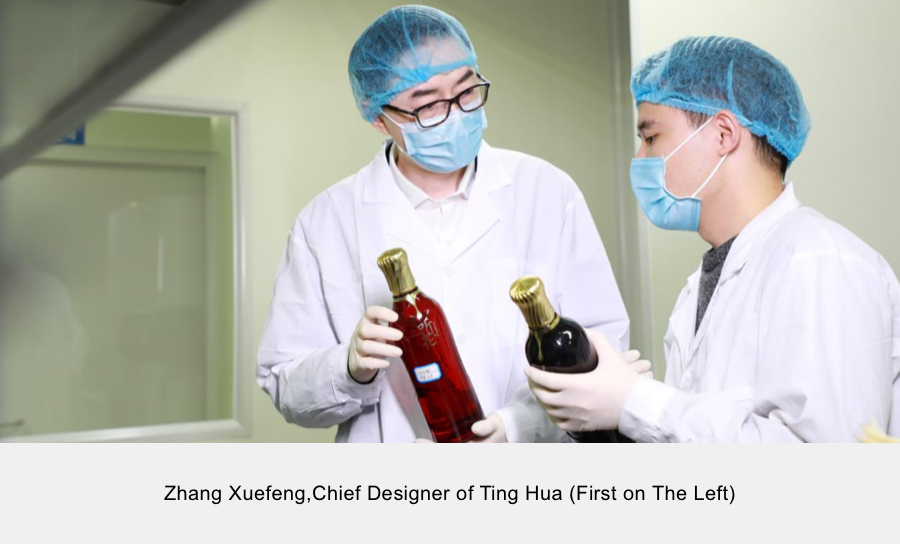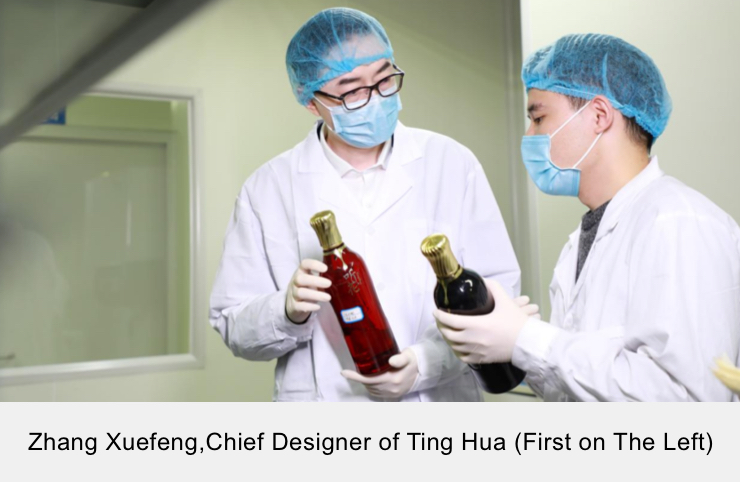

Ting Hua means “listening to the sound of liquor bubbles”, implying the extraordinary Chinese Baijiu-making skills.
As one of the world's six major distilled spirits, Chinese Baijiu enjoys a history of over 1,000 years. In ancient times, skilled spirit craftsman determined the quality of spirits by checking the size and dissipation speed of bubbles when the spirits flowed into the barrel during distillation. While top artisans could even determine the spirits quality by listening to the sound of the bubbles. With such amazing skill, we can study spirits in more ways to further understand the relationship between liquor and people.
This should be inherited from the past into the present.
This is where the name “Ting Hua” comes from.
For better taste and less harm
As a drink favored worldwide, liquor has been accompanied humanity for thousands of years. With the progress of science, people are now furthering their understanding of liquor. Modern research has proven that drinking is related to a number of health problems. But for thousands of years, liquor has been an inseparable part of human life.
As a Chinese Baijiu(Distilled liquor) company, we promoted the idea of making liquor both “tasty” and “healthy” in 2004. In 2016, we conducted systematic research and exploration by defining “Good Liquor of the Future” as our development direction.
Zhang Xuefeng, Chief Designer of Ting Hua Liquor, suggests that Chinese liquor, as the most complex distilled spirit in the world in terms of flavor components, must start from the perspective of caring for the consumer and rely on scientific and technological progress and innovation to achieve a higher sensory flavor and the pursuit of harm-reduction and health benefits thus creating a better consumer experience. This is a very challenging goal: not only to maintain the underlying flavor of grain aroma and mellow, rich characteristics of liquor, but also to meet the health requirements, meaning that no functional raw materials that affect the taste can be used. The R&D team tried hundreds of formulas without success in the interactive combination of objectives, raw materials and processes.


Zhang Xuefeng led the team to conduct research round the clock. It was not until a nap in the laboratory in the early hours of the morning, inspired by a dream, that he found the key to achieve the product's goals. The Ting Hua R&D team then adjusted their formulas thousands of times over 4 years and finally established the “double activation” healthy liquor-making theory and developed the liquor-making system of “directed composition editing” .After at least 109 working procedures and re-brewing of Chiniese Baijiu, they have achieved major breakthroughs in both theory and technique and thus opened the era of liquor re-brewing in China.
The core techniques of this innovative process system include:
Firstly, subjecting mellow aged liquor as the main raw material to secondary fermentation using specially made distiller’s yeast and directed strains of bacteria screened from old fermentation pits, producing richer flavors and increased beneficial components in the liquor body.
Secondly, subjecting the secondary fermented liquor to ultrafiltration(UF), nanofiltration(NF),distillation and concentration processes based on the size of the molecules of the substances in the liquor body and their boiling point. This results in the directional cutting and reorganization of the composition of the liquor, precisely reducing the harmful components that affect the flavor and taste, causes discomfort such as headache, dry mouth, and hangover, while enriching the beneficial components to enhance the taste and body sensation. Compared with the liquor before the brewing process, the flavor and beneficial components of the liquor greatly improves.
The Ting Hua Liquor obtained from our aged liquor rebrewing process, on the basis of the underlying flavor of the grains, brought the liquor’s rich, mellow, layered, and delicate aesthetics characteristics to whole new level, achieving a pleasing palate that is rich in aroma and flavor with a lasting finish.Even when compared with the initial aged-liquor, there is a strong contrast in taste, with the initial liquor appearing to be bland and watery.
The Ting Hua liquor drinking experience is akin to the coming of Spring. Systematic human and animal drinking trails have also provided scientific support for the innovation and and health value of Ting Hua.
Two Nobel Prize winners serve as joint chief scientists of Ting Hua
In July 2022, in recognition of our value and mission, two Nobel Prize Laureates, Professor Ferid Murad and Professor Arieh Warshel joined us as the Joint Chief Scientists of Ting Hua.
Arieh Warshel is the winner of the 2013 Nobel Prize in Chemistry. He is the founder of computational enzymology and pioneered computer simulation of biological system functions. Professor Warshel’s team will guide Ting Hua team to apply his Nobel Prize achievements to product development techniques with aims to enhance liquor taste and flavors so that we can create more value to consumers.
Ferid Murad is the recipient of the 1998 Nobel Prize in Physiology or Medicine. He discovered that nitric oxide is an important signaling molecule in the cardiovascular system and devoted himself to research exploring the effects of nitric oxide on human health. He is also known as the "Father of Viagra" for his Nobel Prize achievement that led to the invention of Viagra. Prof. Murad’s team will guide the Ting Hua R&D team to apply the Nobel Prize-winning results to a wider range of applications, especially on how to achieve more systematic harm reduction and gain effects in liquor production for the benefit of all mankind.